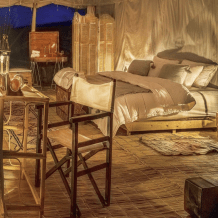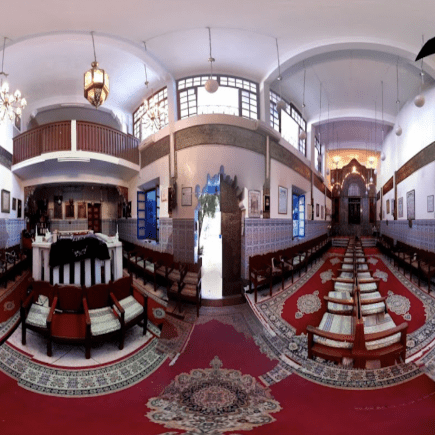
Would you like to Know more about Marrakech’s Jewish Heritage and its 18th Century Synagogues and Stories of the Mellah?
Marrakech is one of Morocco’s liveliest cities known for its historic Jewish Heritage and the famed Djemaa el Fna Square. Marrakech is also a city of fascinating underground channels that were built by the architects from Cordoba, Spain to provide water for the palmeraie. During the Spanish inquisition, Jews fled from Spain to Marrakech, Morocco. Marrakech’s Jewish Heritage can be discovered on a guided tour that traverses the magical medina’s Jewish quarter, exploring synagogues, cemeteries, and historic Jewish life.
At the dawn of the Middle Ages, the Jewish population of Marrakech was estimated at 70,000. By the end of the 18th century, it was 35,000 and continued to decrease significantly over time. In 1936, prior to WWII, there were 15,000 Jews in Marrakech which at present, in 2020 has become less than 75 with 10 currently living in the Jewish quarter. The rest of the Jewish populous of Marrakech resides in the French town of Gueliz.
The majority of Jews in Marrakech and Morocco emigrated to Israel in 1948 upon the creation of a Jewish state
The majority of Jews in Marrakech and Morocco emigrated to Israel in 1948 upon the creation of a Jewish state. Subsequently, the Jewish houses of the Marrakech melllah fell into disrepair with some being purchased by native Moroccans. Today, the Jewish quarter of Marrakech is primarily occupied by Muslims.
The Jewish mellah was historically composed of residential homes, fondouks (merchant warehouses, animal shelters, and accommodation for merchants and travelers), shopping streets and souks that sold spices along with other home goods. The Jewish mellah of Marrakech was above all a place of business and trade where all professions were prohibited from Moroccan Arabs. It was also once the main quarter where communities could find the necessary products to live.
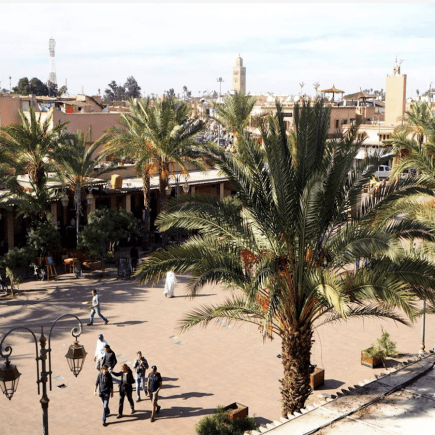
What is The Place des Ferblantiers?
The Place des Ferblantiers is the hub of the Jewish mellah, with the main door leading to this charming enclave. The traditions of Jewish craftsmen who once worked there have been taken over by Moroccan Berbers and Arabs. The spice and jewelry souks have been frequented by Muslims since the XVI century.
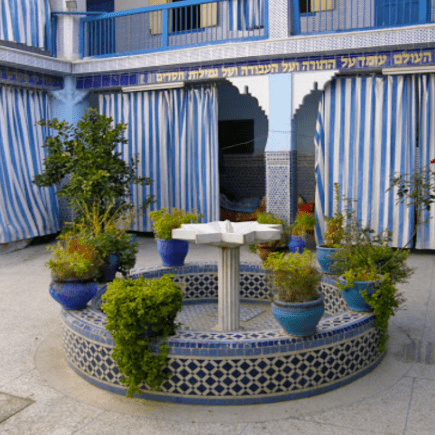
What Can be Discovered on a Marrakech Jewish Heritage Tour?
On a Marrakech Jewish Heritage Tour you will discovery historic synagogues, historical sites and cemeteries and the stories of the mellah.
Explore Marrakech’s Ibn Lazama 16th Century Synagogue
Your journey into Marrakech’s Jewish past will begin with exploring the Ibn Lazama Synagogue, a 16th Century Jewish landmark, and an important testament to Moroccan Jewish life. The synagogues’ architecture is in traditional riad style with a central courtyard. This is the main working synagogue in the Marrakech Jewish mellah and was built in 1492, exactly one year after Jews fled Spain during the Inquisition. If the Lazama Synagogue’s walls could speak they would share stories of famous Rabbi’s and how the Marrakech Jewish community once faced its bema for Torah study and discourse during Shabbat prayer.

At one time there were over thirty synagogues in the Marrakech Jewish mellah. Those interested in visiting more than one working synagogue attending Shabbat services at sunset at either the Lazema Synagogue in the Jewish quarter or the Beth-El Synagogue in the Ville Nouvelle (new town), Gueliz are an option.
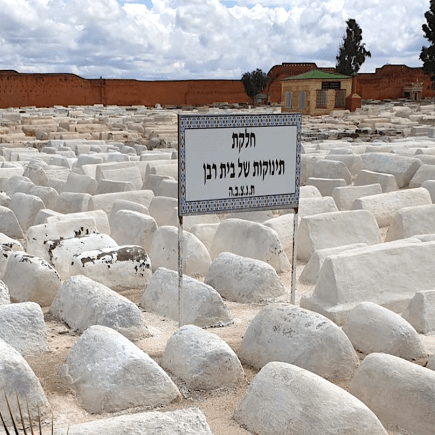
Visit Marrakech’s Miara Cemetery and Jewish Cemetery Museum
Next on the list of historic landmarks, is a visit to the Jewish cemetery Museum and Miara Jewish cemetery that dates back to the sixteenth century. Miara is the only Jewish cemetery in Marrakech. Established in 1537, prior to the Jewish quarter, it has sprawling walls that surround it with white-washed tombs. Historically the Miara cemetery is of great importance to the Jewish community of Morocco as many Tsadikkims are buried there.
Learn about the Stories of the Marrakech Jewish Mellah
On your Marrakech, Jewish Heritage guided tour you will learn about stories of the Jewish mellah that lies adjacent to the King’s Palace. Founded in 1558 by Moulay Abdallah, the mellah district was designated as the Jewish quarter in Marrakech and once home to a thriving Jewish community. At the time of the Spanish religious wars, Jewish refugees were escaping the country and were offered this little piece of security by the Sultan. With the goal to embellish Marrakech and protect the Jewish community, he moved the Jewish population of the old mellah located in the Mouassine district to the foot of the Royal Palace of Hassan II.
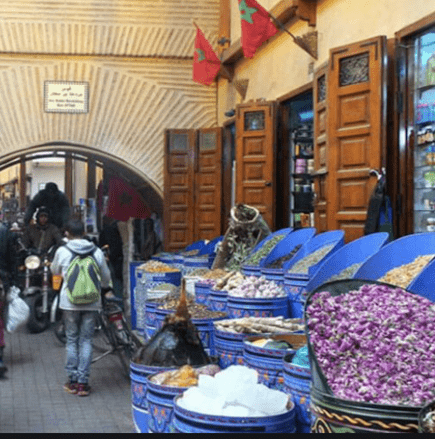
From the 16th to the 20th century, the Marrakech Jewish mellah was similar to other mellahs in Casalanca, Fes and Tangier, Morocco. There were economic challenges, disease, and plagues along with a host of atrocities, executions, and pogroms.
The Jewish mellah of Marrakech is approximately 18 hectares and surrounded by large walls with two access doors on the outside. One entrance door is to the city and the other leads to the Jewish cemetery. The streets in the Jewish mellah, run parallel or perpendicular, with tall houses whereby windows and balconies face outwards.
One of the mellah’s most important features is the Old Spice Souk (Rahba Kedima), a colorful market filled with a wide array of spices from Cumin, Cinnamon, Saffron, Dried Pepper, and more. Rahba Kedima is also home to some of Morocco’s best-spiced coffee which can be purchased by the kilo.
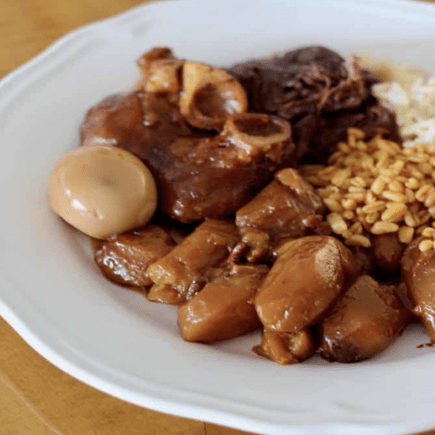
Where can I Spend the Shabbat Sabbath in Marrakech?
An invigorating way to enliven the Jewish spirit and connect with the Marrakech Jewish community is to attend Shabbat services, break bread, and have Sabbath dinner in Marrakech. Sabbath dinner is offered at a traditional Marrakech Jewish home or at the local Kosher restaurant, Dar Ima.
Celebrating Shabbat in the ancient quarter with hosts who are Sephardic and have roots that pre-date the Spanish Inquisition is part of a Marrakech Jewish experience. As cooking on the Sabbath is prohibited, Sephardi Jews, like their Ashkenazi counterparts, developed slow-cooked foods that would simmer on a low flame overnight and be ready for eating the next day. A traditional Sephardic menu commonly made by Jews of Morocco is chreime, fish in a spicy tomato sauce with salads, stuffed vegetables, and vine leaves, eggs, olive oil, lentils, fresh and dried fruits, herbs and nuts, and chickpeas. A meat dish made of lamb or ground beef and Moroccan chicken with olives is also served. The mains meat dish will have dried fruits such as apricots, prunes, and raisins.
Other highlights featured on a Marrakech Jewish Heritage Tour include visiting Moroccan Historical & Cultural Sites: Yves Saint Laurent, Majorelle Gardens & Berber Museum, the Bahia Palace Gardens, Ben Youssef Medersa, and Koutoubia Mosque.





